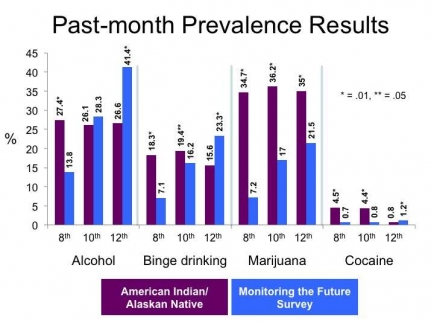We have long known that American Indian communities are particularly vulnerable to problems with substance use, which are tied in part to limited socioeconomic opportunity. But because national surveys fail to fully capture drug use patterns on or near reservations, the true scope of the problem has been elusive. A new study focusing on American Indian youth reveals alarming substance use patterns, including patterns of drug use beginning much earlier than is typical for other Americans.
A team of NIDA-funded prevention researchers at Colorado State University analyzed data from the American Drug and Alcohol Survey given to American Indian students at 33 schools on or near reservations in 11 U.S. states in 2009-2012. A comparison with nationwide data from the Monitoring the Future (MTF) survey is striking, particularly in the much higher prevalence of drug and alcohol use in 8th and 10th graders compared to national averages. In 2009-2012, 56.2 percent of American Indian 8th graders and 61.4 percent of those in 10th grade had used marijuana, compared to 16.4 percent of 8th graders and 33.4 percent of 10th graders in the MTF survey. American Indian students’ annual heroin and Oxycontin use was about two to three times higher than the national averages in those years.
Also noteworthy was the finding that American Indian youth are initiating alcohol and drug use earlier than their non-native counterparts. As can be seen in the graph below, past-month (current) use of marijuana and alcohol (including binge drinking) were at the same level from 8th through 12th grade for the American Indian students, which sharply contrasts with the steep increases from 8th to 12th grade seen in MTF. Although current alcohol use by American Indian 12th graders was lower than the MTF average (one positive note in the study), current marijuana use stood at 35 percent for American Indian seniors—much higher than the 21.5 percent in the MTF survey.
Data collected by the researchers on regular (daily or near-daily) marijuana use by American Indian adolescents (although not included in the article) is particularly startling: Fully 8 percent of American Indian 8th graders said they were regular marijuana users (compared to 1.3 percent of MTF 8th graders); 14 percent of American Indian 10th graders reported regular use (compared to 3.6 for MTF); and 15.3 percent of American Indian seniors reported regular use (compared to 6.6 percent for MTF). The strongly suspected links between regular marijuana use and outcomes like academic failure and long-term cognitive impairment make these statistics highly worrisome.
Indeed the already high rates of marijuana use seen for American Indian 12th graders may actually underestimate marijuana use prevalence in this age group. Only about 47 percent of American Indian teens finish high school—compared to 71 percent of non-native teens—and drug use is generally higher in those who do not attend school.
This study is quite a wake-up call. High substance use in American Indian communities contributes to a range of social problems including violence, delinquency, and mortality from suicide or alcohol or other substance abuse. Thus these findings alert us to the urgency of implementing prevention programs in these communities. Moreover, given that American Indian youth are already using drugs and alcohol at high levels by the time they become teenagers, we clearly must do more to intervene at an earlier age.
Several early childhood interventions, such as the Nurse-Family Partnership, have been shown to effectively (and cost-effectively) reduce adolescent drug use and related problems in disadvantaged communities by targeting risk and protective factors as early as the prenatal period and infancy. Another program, Family Spirit, is tailored specifically for American Indian teen mothers and has shown positive early results. Early prevention using these or other interventions is crucial, lest we lose another generation of American Indians to substance abuse and addiction.

